HOW 'THE WEST' WAS DONE
DVD REVIEW BY GARAN GREY
This epic is making a big splash on DVD and Blu-Ray, in a meticulously enhanced special edition, with a number of technical details unique to this release.
The Cinerama process was a groundbreaking and trendsetting success that sparked the beginning of the widescreen stereophonic era of film production. After several Cinerama travelogue features, Cinerama Inc. partnered with Metro Goldwyn Mayer to produce narrative features in the format. The first was the storybook fantasy THE WONDERFUL WORLD OF THE BROTHERS GRIMM, released in late 1962, followed by HOW THE WEST WAS WON in early 1963. Soon after, Cinerama Inc. was bought by Pacific Theatres, who effectively killed off the process by switching to simple 70mm for all subsequent releases.
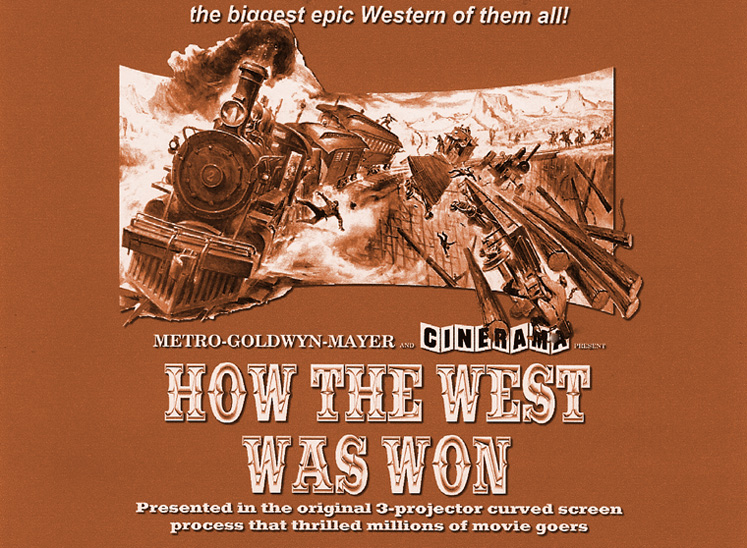
Cinerama films were photographed by three lenses, arranged in a curve, on a single camera, which produced three separate picture elements, intended to be shown on a 146 (sometimes 126) degree curved screen. Although every effort was made in Cinerama presentation to minimize the join lines between the three panels of the picture, they were plainly visible. By the time HOW THE WEST WAS WON was produced, the filmmakers had gotten fairly good at lining up shots to hide the join lines in vertical points like posts, walls and trees.
When the three Cinerama panels are lined up and presented on a flat surface, there is naturally some geometric distortion when people or objects pass the join lines. A horizon line that appears straight on a curved screen, will will bend upward at the side panels when shown on a flat plane. All previous letterboxed transfers of HOW THE WEST WAS WON have this distortion, and the current letterboxed transfer of THE WONDERFUL WORLD OF THE BROTHERS GRIM still does.
During post-production of a documentary on the Cinerama process, special effects experts and Cinerama buffs devised a way of joining the three panels, and optically spreading the picture on the ends, to simulate the curve of a Cinerama screen. Not only did this simulate the panoramic sweep of Cinerama features, it also practically eliminated the bending distortion at the panel join lines. This innovative technique was dubbed "Smilebox" because of the shape of the image.
As HOW THE WEST WAS WON was prepared for a definitive DVD release, Warner Home Video put a good deal of effort into presenting this unique material to its best advantage...
Although the word "restoration" is tossed around quite a bit in marketing of older pictures, (including this one) it is somewhat inaccurate in this case. This point came up in 2002, when Warner Brothers agreed to have two new Cinerama prints struck of HOW THE WEST WAS WON for special showings at the three remaining theatres capable of showing Cinerama. When the new prints were first shown, some advertising referred to them as "restored." While unintentional, this was a bit of an insult to Warners and the people responsible for the MGM/Turner film library...
A true "restoration" - as was done for films like LAWRENCE OF ARABIA, SPARTICUS, VERTIGO, MY FAIR LADY and FUNNY GiRL, involves original elements that are damaged, worn or aged to the point where they no longer represent the quality of the original film. Restoration involves assembling all of the best available elements, and employing the best available technologies, to bring the picture back as close to its original quality as possible, (sometimes better) at which point new archival negatives are created for future use. Warner Brothers, and the people responsible for the MGM/Turner Film library, had taken such good care of the HTWWW elements that nothing like a restoration was necessary. The material was in such good shape that new prints could be struck from the negatives without any extra work being done.
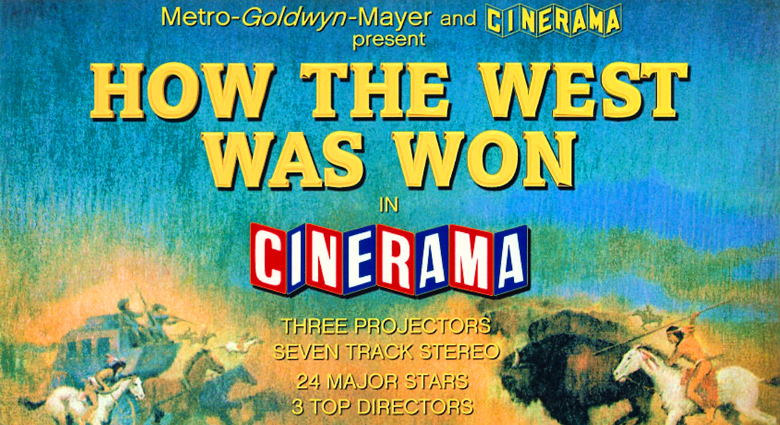
In bringing HTWWW to high-end home theatre, Warner Home Video treated the picture to quite a long makeover. There is always a fair amount of tedious frame-by-frame cleanup, color matching, removing imperfections, etc. We presume that process is what the studio refers to when calling this video transfer a "restoration" although it involved no work on the actual film elements. An extra painstaking effort was made to optically match the Cinerama join lines to the point where they are much less visible. Add on the Smilebox process, and you end up with a result that could look more perfect (though not less impressive) than a three-strip Cinerama print on a curved movie screen.
Understanding the distortion caused by presenting Cinerama's three picture panels on a flat plane, and the vast amount of effort made to ensure HOW THE WEST WAS WON looks as perfect on Home Video as possible, brought up an interesting question... would the flat letterbox version retain the pre-Smilebox distortion, or simply be "adapted" (cropped) from the undistorted Smilebox version? That question hasn't been completely answered, but obviously there was some digital image manipulating done to straighten out the horizontal distortion in the flat letterbox image, so it looks okay in that respect, but the letterbox version has another problem...
The camera negative contains more picture outside each of the three standard frames than was intended to be seen. Warners scanned the entire negative, in hopes that the extra picture area in the three panels would help in lining them up to match at the join lines. However, the extra area on the outer edge of the left and right of panels was kept in, extending the already generous width of Cinerama's native 2.59 aspect ratio into a whopping 2.89.
Within the finite width of television monitors, the wider a letterboxed image is, the shorter the picture height becomes. Standard 2.35 widescreen movies are smaller, but still fairly watchable, and 2.59 would be an even shorter picture height, but accurate to the intended dimensions of the Cinerama format. At 2.89, this new letterboxed version is like a ribbon across the center of the screen. A picture postcard of a movie. If you have a huge Hi-def Widescreen monitor or a projection setup, this may be okay, but woe to those of us with 26" or less. The unnecessary extra bits of landscape at the far ends were not intended to be seen, and definitely not worth losing more picture height.
Warners announced three different versions. A Standard DVD set, an "Ultimate" box set, and a Blu-Ray set. A good deal of confusion has stemmed from Warners flip-flopping announcements and constantly changing product images regarding the number of discs in the standard and "Ultimate" box set. Initial product images showed the "Ultimate" box to contain three discs, while the (discs-only) standard DVD and Blu-Ray set each had two discs. However, images and product listings were eventually changed, because the word from the studio was there would be only 2 discs in all versions. Another question based on the information found online, was what material would be on what set?
As product information mentioned that a 90 minute Cinerama documentary was to be included on the Blu-Ray and "Ultimate" sets, many of us decided to buy one of those, but we began to wonder how the 164 minute feature, plus the promised four plus hours of bonus material, would be contained on just two discs.
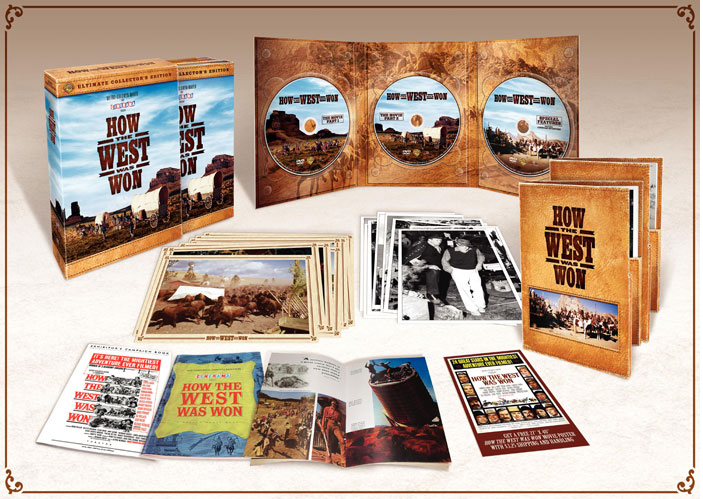
The product images clearly show that the items found in the "Ultimate" box are not in the Blu-Ray package. There is a book bound into the package, which may duplicate some of the material in the box, but it clearly isn't the "Ultimate" as far as the paper extras go.
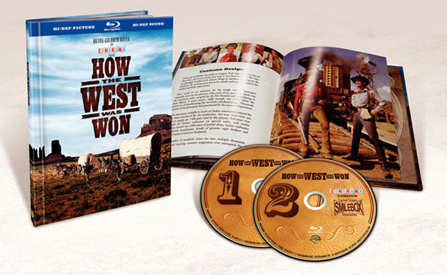
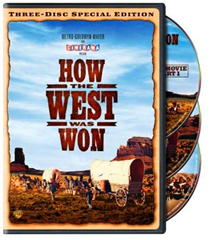
Even more confusion comes from the wildly inaccurate product information on Amazon, such as this being the "first and last movie shot in true Cinerama" and the aspect ratio of the "Ultimate" edition being listed as 2.35, (now 2.55) with the Blu-ray version originally being listed as 1.33.
The studio descriptions still claim over four hours of extras, but that's really misleading. First of all, the promised 40 minute "Making of HOW THE WEST WAS WON" featurette is nowhere to be found on any edition. A terrific 3-panel Cinerama trailer for the movie exists, and the elements were readily available, but that's not included either. You do get the 90 minute Cinerama documentary, and a very good commentary throughout the 164 minutes of the feature, but that's about it on the discs. If you count the commentary and the doc, that is over four hours, but, come on!
When it was first posted for pre-sale on Amazon, the "Ultimate" box set was being sold for $19.99. Yes, that's a great price. However, once we posted that price here, it went up to $29.99, and soon after, to $41.99. When the discs were finally released, many of us who had already sprung for the "Ultimate" box, thinking only that one had the video extras, discovered that the regular (discs-only) edition had exactly the same three discs as the "Ultimate" edition, but for less than half the price! The Blu-Ray crowd gets the "Smilebox" transfer and a price break, costing not much more than the basic DVD package, with just a hint of the packaging and paper extras found in the big box. it's really hard to see any logic in all those decisions.
The biggest issue causing anger from consumers seems to be the fact that Warner decided not to include the definitive "Smilebox" version of the feature in the so-called "Ultimate" set. It was clearly a marketing decision intended to sway more people to buy Blu-Ray players, but it's a bad idea for several reasons. First, Blu-Ray is still a niche market - maybe about ten percent of all DVD owners have it. Second, the U.S. is going through financially tough times. Not only do you have to buy a new player to watch Blu-Ray, you have to buy a high definition monitor too, and most folks simply can't afford that right now.
When other studios include features exclusive to Blu-Ray, they're mostly features that only work in the expanded technical capacities of Blu-Ray. It is certainly not true, as Warners suggests, that the "Smilebox" version requires the higher definition of Blu-Ray. Standard DVD owners who see the "Smilebox" scenes in the Cinerama doc think it looks just fine, and many would prefer to watch the movie that way, but for the huddled masses, Warners has declared "no Smilebox for you!"
With the "Ultimate" edition costing more than twice the price of the discs-only set, there is really no excuse for not including the "Smilebox" version in the box. it would require an extra disc or two, but Warner has done four discs for other "event" movies (GONE WITH THE WiND and BEN-HUR, both excellent packages, come to mind).
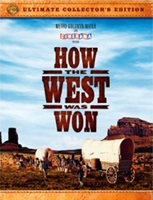

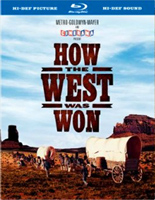
One of the things that distinguishes Warner Home Video from the other studios is the exceptionally good way they handle their catalog titles. Warner is usually very good at adding some extras, often including shorts and cartoons that can make up a home version of a vintage night at the movies. (which makes it extra disappointing that they haven't done it here) We have always given them high marks for their brilliant packaging design, with a high standard of using what appears to be the original poster art, but is really the original art cleaned up and enhanced for today's market. Through the years when WBHV was ruining the lineup of DVDs on our shelves by packaging them in those heinous "clip-cases" (that literally stick out from the others and catch on each other) the studio still broke even in our book, because the considerable ill-will those cheap cases generated was almost balanced out by their stellar art direction. The packaging of the HTWWW sets is typically attractive; like the clip-cases, we have bad decisions attractively packaged.
Bottom Line: The letterbox picture quality is quite good, (the join lines are not "eliminated" as the product info claims, they're minimized) the horizontal distortion in the flat letterbox transfer is somehow corrected, but the unnecessary extra width, not originally intended, makes the image smaller than it needs to be. The Cinerama documentary can clinch the sale for those who are iffy about the feature itself, but it is thoughtless to leave out the "making of" featurette from the previous DVD, especially when you have promised it in all the press and product descriptions! No excuse for leaving out the Cinerama trailer, either - in fact, throwing in the trailer for BROTHERS GRIMM would have been a very smart move. The paper extras in the "Ultimate" box are really very nice, but are they really worth more than double the price of the discs alone? And how can you call it the "Ultimate" if you don't include the "Smilebox" version?? The "Smilebox" is really the best way to watch the film, but you're out of luck if you're not affluent enough to replace most of your home theatre equipment. And if you are, well, you don't quite get all the special paper extras that the poor folks are paying through the nose for. SO... this is very nice effort, but riddled with bad decisions all around. I'd recommend the discs-only version as the best value for the price.
Update 2012: Enough time has passed to make any version of this release affordable. I ended up with both Blu and Ultimate box versions. Though we wish there had been more features, there is real entertainmant value there, so as always, we recommend you follow your interest level and your budget.
TJ Edwards - Tech info Review - Garan Grey
Rare HOW THE WEST WAS WON Original Poster For Sale
The BBC looks at the process of preparing HOW THE WEST WAS WON for DVD and Blu-Ray
If you have some thoughts on this, or other DVDs you have or want, post in our DVD Forum.
The definitive online resource for information on Cinerama and other Widescreen movie formats, is The American Widescreen Museum, created by film historian, graphic artist, and all around nice guy Martin Hart. Mr. Hart has created one of the most impressive and fascinating websites we have ever seen, so you'll want to set aside a few hours to fully appreciate all of his work.
Theatrical Ad Art adapted by Martin Hart of the American Widescreen Museum
Images © MGM/Turner/Warner

